Fun Facts About Zucchini
The Italians are credited for first introducing Zucchini to North America in the 1920’s. In fact, the word “zucchini” comes from the Italian word for squash, “zucca”.
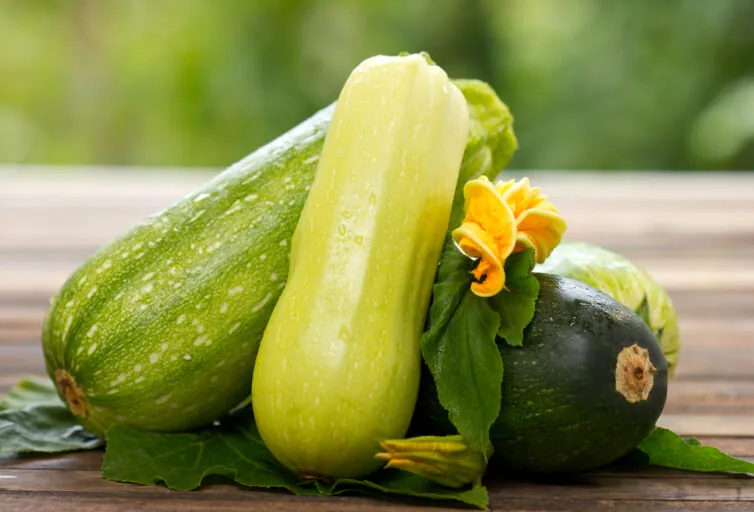
Here in Arizona, zucchini (one of the most popular summer squashes) is exceptionally easy to grow and you may well find yourself with an abundance of these mild-flavored fruits. If you find yourself with a garden full of this notorious green food, it may do you well to get better acquainted with them. Here are some interesting facts that we here at Fill Your Plate have dug up, so to speak.
- Zucchini is credited with several health benefits including (but not limited to):
- Zucchini contains more potassium than bananas.
- One zucchini has only 25 calories (in comparison, a baked potato has 130 calories).
- Zucchini are low in sodium, contain no saturated fats, and are cholesterol-free.
- They are rich in vitamin C and manganese.
- The peel is a good source of dietary fiber and may help in reducing constipation.
- Dietitians often include zucchini in their cholesterol control and weight loss programs.
- According to World’s Healthiest Foods Nutrition Information, the vitamins and nutrients found in zucchini can help prevent heart disease and cancer.
- It has anti-oxidant benefits. Much of the antioxidant nutrients are found in the seeds and skin of the plant, and not just its flesh. So it is important to consume it without peeling the skin. To retain the strongest amount of anti-oxidant benefits, steaming is recommended over baking or boiling.
- Selecting the right zucchini:
Now that we know how nutritious and beneficial consuming zucchini can be, you may be wondering how to select the best zucchini for your meal. Did you know that the largest zucchini on record was grown by Bernard Lavery of Plymouth Devon, UK, and was 69 ½ inches long and weighed a whopping 65 lbs.! However, his zucchini probably didn’t taste all that great. See, with the zucchini plant, bigger isn’t always better. In fact, small to medium sized zucchini (6-8 inches in length, 2 inches or less in diameter) pack the most flavor. If you can find a small-ish one with darker skin, that’s even better, as the dark skinned zucchini have the most nutritional value. Choose one that is heavy in hand and firm to the touch. It is better to avoid zucchini with pitted skin and a spongy texture, as these are overly mature and moisture less, resulting in a bitter and unpleasant flavor.
Zucchini flavor is at its best in late spring and summer seasons, but is usually available year round. Did you know that the flower (or blossom) of a zucchini plant is also edible? In fact, fried squash blossoms are considered a delicacy in many places. In addition to frying, the blossoms taste great when baked or steamed, stuffed with cheese. Popular in Mexico, they are often cooked into quesadillas and soups.
- Storage and Preparation:
After you have chosen your zucchini and have brought them home from your favorite store or market, or even in from your garden, it is best to store them in a plastic bag inside the vegetable compartment of your refrigerator. The compartment should be set at adequate relative humidity. To maintain the best flavor quality, zucchini should be stored for no more than 2-3 days. Before cooking, thoroughly wash the zucchini in running, cold water. In some cases you may need to lightly scrub them where dirt may have become firmly attached. You should trim the base and the neck, but remember not to peel the skin, as many of the valuable nutrients will be lost if you do.
- Eating your Zucchini:
Zucchini is highly versatile and can be consumed both raw and cooked. Zucchini bread is, perhaps, the most popular way to eat zucchini. So popular that it even has its own special day, National Zucchini Bread Day is April 25th. Zucchini is a delicious addition to pasta sauces and soups, like this minestrone recipe. It is also wonderful as the star of the show, as proven with this delectable “puffed up zucchini” recipe. You can even add it shredded and raw to your favorite salad for a nutritional punch.
Good for you, easy to grow, and easy to find, zucchini is a wonderful food to experiment with. Have fun with it and discover how you best enjoy it! To help you get started take a look at the recipes we have collected here. And be sure to make your favorite dish on August 8th in celebration of National Zucchini Day!
Related articles
- How well do you know your zucchini? (fillyourplate.org)
- Sweet Potato-Zucchini Bread (fillyourplate.org)
- Zucchini Sweet Potato Frittata Will Make You Sing “Hakuna Matata!” (fillyourplate.org)
Asparagus Fun Food Facts
Asparagus, low in calories and high in protein and fiber, is also simply loaded with potassium and folic acid. A perennial vegetable particularly suited to Arizona’s climate, soil conditions, and moisture, it can live up to 15 years. It also thrives with minimal care, and welcomes raised beds (i.e., where soil can be added over the crowns of the plants).
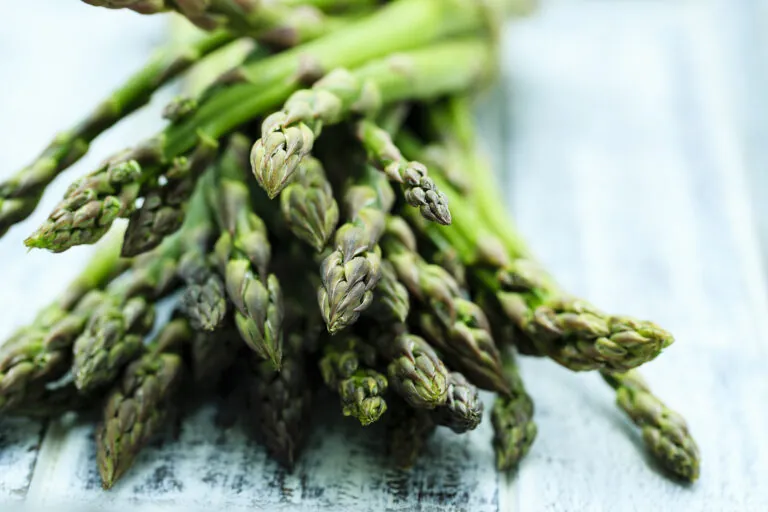
Asparagus also has some very weird characteristics, but first, the health benefits. With a mere 20 calories in five spears and 2.3 grams of protein, asparagus is highly nourishing. Doubtful shoppers, or those who have never tasted asparagus, can no doubt find some locally (in Yuma, Maricopa, or Pinal – three of the 13 Arizona Farm Bureau member counties). One taste is sure to convince!
Asparagus does flower, but the flowers are typically so small – stems or spikes of white, six-petalled flowers – that they are noticeable only when in full bloom. The flowering forms of asparagus are a different cultivar; densiflorus rather than officinalis, with the common name Asparagus Fern, and an annual rather than perennial habit.
Of course, this depends on the type. Those who forage for wild asparagus, Asparagus officinalis, know that the flower spikes are an indication that the spears will already be bitter. These connoisseurs prefer to mark the patch and come back in the early spring.
Cultivated, or hybrid, asparagus, typically does not flower. That is because the plants have been domesticated to include all (or mostly) males. It is probably the only species in the plant kingdom where male species are purposely selected, and these hybrids are sold under names like Millennium, Mondeo, Pacific Purple, Pacific 2000, and Stewart Purple.
White asparagus is not a hybrid but a way of growing asparagus. In the dark, mounded with soil (so that the stalks grow without chlorophyll), this premium form of asparagus – reportedly sweeter than the green variety – will still produce green leaves and flower stalks above ground.
White asparagus is higher in carbs, but so very few it can still be part of a healthy diet, even one for type 2 diabetics. At 3 grams of carbs but 2 grams of fiber (which reduces the glycemic index), white is better at delivering a daily helping of “green” than an equivalent amount of peas, for example.
If you are watching calories or carbs, you can keep both low by blanching, steaming, or microwaving asparagus. If you don’t think your family will enjoy it plain, reserve a portion and make the rest more palatable by choosing delicious recipes like Goat Cheese Lettuce Wraps, or the scrumptiously spicy Julie’s Oven Roasted Red Potatoes & Asparagus.
Now for the weird stuff:
- The name, which comes from Greek, means something whose origin is unknown, or obscure, but Late Medieval writer William Pepys called it “sparrowgrass”.
- Biochemists have isolated sulfur-containing compounds in asparagus that cause urine to smell weird. Don’t worry, you aren’t sick, it is just your kidneys breaking down the asparagusic acid – a chemical found only in asparagus.
- Asparagus etiquette dictates serving the vegetable on a ceramic plate (something to do with its acid content, no doubt). Oddly enough, dedicated asparagus serving forks and tongs, especially the antique variety, are made of ivory, silver, and gold plate.
- The Romans started to cultivate asparagus more than 2,000 years ago. By that time, it was familiar (as food or medicine) to the Spanish, the Syrians, and the Egyptians. It arrived in Northern California in the 1850s, along with the California Gold Rush – luxury food for miners who had struck it rich.
- Asparagus is good for a hangover! The proof is scientific but the discovery probably dates to antiquity. Modern conclusions about its ability to cure cancer, prevent or heal fungal infections, prevent inflammation, and eliminate excess water, can be found in the medical literature.
- Asparagus is a love potion! Wikipedia, via an Arabic source, confirms this. A newer document dismisses the notion. Seems the rarity of the item, and (in the case of white) its high cost, influence the psychology of the receiver more than any potential hormones being stimulated.
Related articles
- 10 Amazing Things about Asparagus (fillyourplate.org)
- Julie’s Oven Roasted Red Potatoes & Asparagus (fillyourplate.org)
- Using Food to Fight Stress (fillyourplate.org)
Mesquite Flour, an Arizona Native
The last 15 years have seen the arrival or rediscovery of such ‘designer’ flours as mesquite flour, rice flour, amaranth flour, even chickpea flour, each lending a unique flavor to a particular type of ethnic cuisine. These flours, especially the first, also offer gluten-intolerant consumers dietary alternatives.

Made from the pod (or bean) of the mesquite, a bush or small tree, this low-cal, high-value flour was first developed and used by Peru’s indigenous people.
Later, Native American inhabitants of the Desert Southwest discovered its value. To this day, the mesquite remains a boon to those living in America’s deserts – from the Chihuahuan Desert in southern New Mexico and southeastern Arizona to the Sonoran Desert spanning Arizona, California, and Mexico – who value native plants and their uses.
For example, in xeriscaping – also known as desert landscaping – the drought-tolerant mesquite provides food for humans and animals. The latter include bighorn sheep, antelope, ground squirrels, ravens, and quail. The blossoms provide nectar for bees (both wild and domesticated), and habitat for birds, notably hummingbirds.
Mesquite flour, made by drying and grinding the whole pod, is rich in the sweetness of fructose, or fruit sugar. In spite of that, it is surprisingly effective among diabetics in controlling blood sugar. This is because humans can process fruit sugars without the use of insulin.
Mesquite flour is also high in a type of natural gum that slows digestion from an average 1.5 hours to five, keeping blood sugar levels regulated.
If mesquite flour is not quite as common as rice flour, it is because the mesquite bush has armed itself with seriously painful thorns. Scientists speculate that this is an-ice age adaptation to prevent large animals like mastodons and ground sloths from eating the plant into extinction.
The defense still works today, but devoted mesquite flour advocates can arm themselves with knowledge. One good source might be the Moody Orchards-Arizona Mesquite Co., proprietor Mark Moody. The company not only makes its own mesquite flour, it also sells the wood to artisan carpenters around the globe. To buy their flour, call 928-851-1861 or skyrace999 @ gmail.com.
From a dietary standpoint, it is important to know that mesquite seeds (within the pods) are 40 percent protein. Add to that high values of calcium, iron, manganese, potassium, and zinc, and the wealth of soluble fibers, and mesquite flour tops even amaranth flour in nutrition. Moreover, mesquite flour is ‘total protein’; that is, it contains all eight essential amino acids.
A few cautionary notes to mesquite ‘newbies’:
- Taste a pod before picking a bush to make sure the flour will be palatable.
- Ripe pods are golden brown, like wheat, and snap like crisp celery when broken.
- Do not confuse mesquite with highly toxic black locust, or less palatable honey locust pods.
- Do not pick bushes located near traffic corridors, where exhaust is heavy or continuous. Also, do not pick near known locations for insect spraying, or off the ground, where highway runoff, animal waste, and other hazards can contaminate the pods.
- Pick before – or well after – the rainy season to avoid and/or prevent invisible toxic molds, or aflatoxins.
- Dry perfectly, then store beans in paper or cloth bags where safe from rodents. Food-grade plastic and metal buckets seal even more tightly, but may create mold if beans are not completely dry, so use bags and try hanging the bags from the rafters.
- Never mind the little holes in the pods, from which harmless beetles will emerge (after having eaten a few beans during its larval stage). Sharing is part of the new mindset some call ‘eco-eating’.
- Beans must be absolutely clean before milling operations will accept them
Recipes for mesquite flour baked goods can come from other enthusiasts, from gluten-free bakers, even from grocers who sell mesquite-flour foods. Recipes for baked goods are also available on Fill Your Plate; simply substitute one-third (or more) mesquite flour for wheat flour until the recipe ‘works’.
If all this sounds too labor-intensive for busy lifestyles, Moonrise Farms in Concho sells mesquite flour baked goods. In Prescott, the Crossroads Café serves some mesquite-based products. There is even an eatery in Washington, DC – the Mitsitam Café, in the National Museum of the American Indian – that advertises its mesquite flour-based foods.
Related articles
- Little Known Facts about Olive Oil (fillyourplate.org)
- Gifts for the Foodie in Your Life (fillyourplate.org)
- The Secret to Looking and Feeling Good (fillyourplate.org)
Blog managed by 23Kazoos.com.
Arizona’s Original Super Boll!
The Cotton Bowl is over, the winners declared. But in Arizona, where cotton is once again king, the real Super Boll is the cotton plant.
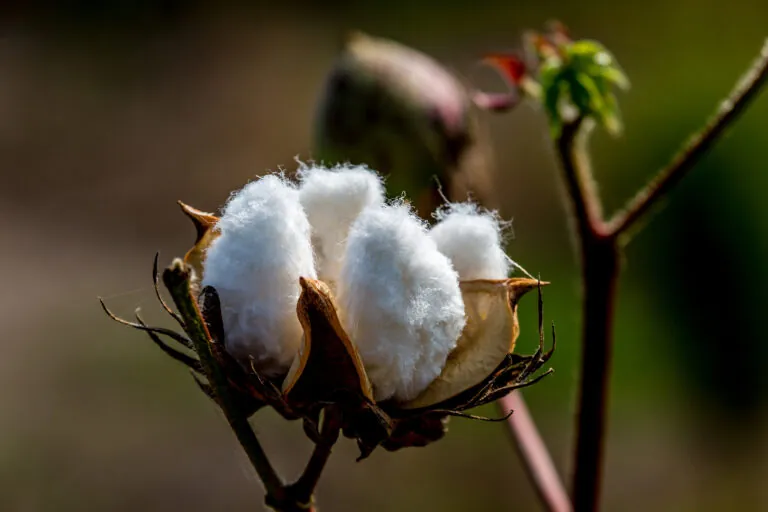
Boll refers to the round ball of cotton that develops at the end of the cotton plant’s stem. Technically a flower, these bolls – bursting from dried shells that cut like knives – were once harvested by hand. This was a difficult, painful, and time-consuming process, and required an enormous amount of labor. But in 1794, Eli Whitney patented an invention he called a cotton gin, and suddenly labor was no longer an issue.
Cotton cultivation dates back to Egypt. In this century, the biggest growers are China and India – which are also the world’s most populous countries. The United States comes third in number of bales, but first in per capita production.
Closer to home, states growing the most cotton lead with Texas and end with Kansas. Arizona comes in 13th in production, but first in quality! This is because Arizona is a premier grower of the finest extra-long strand (ELS) cotton in the nation on a per capita basis. Known commercially as Pima cotton, these ELS fibers must be at least 3/8 inch longer than short staple cotton, or nearly an inch. Today’s Supima cotton (the brand name for premium Pima cotton) exceeds staple cotton fibers by up to half an inch.
According to the Cotton Growers Buyer’s Guide 2014, the West (Arizona, New Mexico and California) produce a boll whose strand length is 36.9 thirty-seconds of an inch. Equally as important, only California and Arizona are stamped for superior quality when grown for export.
The Deep South (Alabama, Florida, Georgia, North Carolina, South Carolina and Virginia) grow 30 percent of the nation’s cotton, but their ELS rating is only 35.3 thirty-seconds of an inch. Texas, Kansas and Oklahoma account for 37 percent of the nation’s cotton production (most of this in Texas), but again the ELS quality is only 35.5 thirty-seconds of an inch.
How did Arizona reach this peak of quality cotton production? In 1907, the US Department of Agriculture, or USDA, established an experimental farm in Sacaton, in cooperation with the Indian Service. Their intent was to crossbreed existing wild strains of cotton with a cotton plant known as American-Egyptian, in hopes of creating a very long-fibered, strong cotton plant that could be grown in the harsh desert climate.
The name “Pima” comes from the tribe of Native Americans who lent their support to this project. These Pima had adopted an ancient (Hohokam) canal irrigation system and were skilled at growing cotton.
Today, thanks to a number of Pinal County seed companies, transgenic cotton – also known as Bt (Bacillus thuringiensis) cotton – has been developed and released. This biotech miracle solves the problem of cotton pests like the pink bollworm, an obstacle to ELS cotton growing that became almost overwhelming in the 1990s, when climate change tipped the biosphere in favor of unpredictable weather and hardy insects.
As Brent Murphree, third generation Arizona cotton farmer, notes in his article: “The progressive cotton farmers of Pinal County continue keep pace with the world by breeding efficient new varieties, cleaning up the environment by using more earth friendly pest control measures, and utilizing the latest technology in electronics, water conservation and mechanization to increase their productivity.
“For many, cotton is still king in Pinal County.”
Related articles
- Fun Facts about Cotton (fillyourplate.org)
- Happy Birthday Blue Jeans!! (fillyourplate.org)
- Arizona Agricultural Exports (fillyourplate.org)
Fun Facts about Cotton
When I say “cotton”, most of you will think of blue jeans.
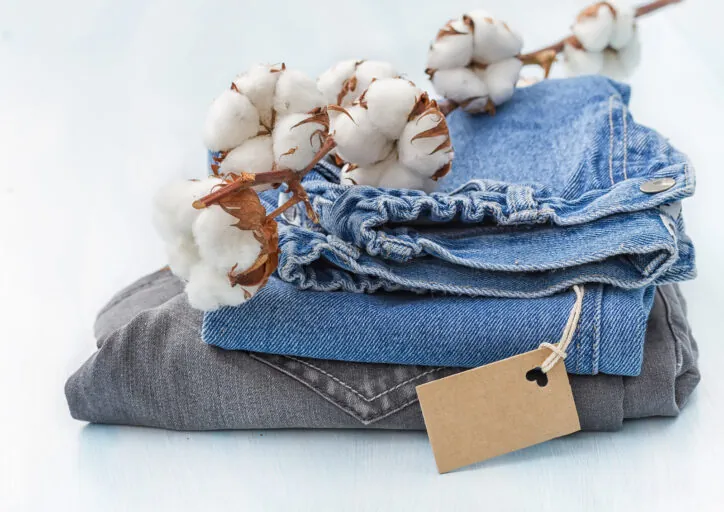
Ubiquitous, comfortable, sturdy but sexy, these garments have remained true to their 18th century origins – all cotton, all blue, all the time.
The name of the cloth may come from a French town, but the product itself is as American as apple pie. Invented for California gold miners, these tear-and-puncture resistant ‘waist overalls’ have the advantage of copper rivets to keep the pockets from tearing away.
The inventor was Levi Strauss. The cotton came primarily from America’s Southern plantations. That has changed. Today, some of the world’s finest cotton comes from Arizona. Developed in the early 1900s, this ELS (extra-long staple, American-Egyptian) cotton was named after the Pima, a Native American tribe that grew the experimental cotton for the US Department of Agriculture, or USDA, in Sacaton, Arizona.
As of December 2014, cotton was again Arizona’s leading export, with fresh vegetables running a close second. Some other interesting facts about cotton include:
- Improved seed varieties have decreased pesticide use to almost zero, so wear your “blues” with pride.
- Not all cotton is white. In Peru, the Mochica tribe grows bolls ranging in color from deep chocolate to mauve and even purple, and protects the secrets of colored cotton almost religiously.
- Cotton is accused of being “a thirsty crop”. From boll to closet, a simple t-shirt reportedly uses 713 gallons. However, modern farming techniques can (and do) reduce that to 284, and improve yields by about 30 percent.
- Arizona cotton farms produce enough top-grade cotton to make one pair of jeans for every single American, including the littlest ones.
- Cotton is the world’s largest non-food crop. Cottonseed oil is used to make cooking oil and margarine, and in cosmetics. It is also high in antioxidants like Vitamin E.
- Cotton fiber is the “background” for such diverse fabrics such as velvet, corduroy, and flannel.
- Cotton sheets and pillowcases are currently graded by thread count, which is a marketing lie. The best sheets are made from ELS, or pima cotton, and woven via the “percale” method. (Yes, that is where the word comes from).
- Cotton goes a long way. One bale (500 pounds, or as heavy as a grizzly bear) can make 215 pairs of blue jeans, 680,000 cotton balls, or 6.5 million cotton swabs.
- Cotton has been cultivated in Egypt for centuries. At one time, only the High Priest was allowed to wear it.
- Thomas A. Edison’s first light bulb filament was made from cotton.
- Cotton makes up about 40 percent of the world’s fiber production.
- Cotton also makes up 75 percent of the U.S. “greenback”, or folding money. The rest is linen. No paper is involved in making “paper currency”.
- Cotton can be made wrinkle-resistant by adding a chemical finish, or by layering individual fibers (which then act as support for one another when folding or putting weight on them).
- Cotton exports put the U.S. at number 1!
- Cotton, as clothing fabric, has been around for 3,000 years; cotton farming has been around for 5,000.
Cotton, dubbed “The Fabric of Our Lives” by an advertising campaign, certainly lives up to its billing, doesn’t it?
Related articles
- Arizona Cotton Harvest as Experienced by Jan D’Atri (fillyourplate.org)
- It’s High Cotton but High Costs (fillyourplate.org)
- Cotton Pickin’ Fun on the Farm- Cotton Crafting (fillyourplate.org)
Surprising Facts about Broccoli That Will Make You Go WOW!!
Did you know? Broccoli, that intensely green vegetable with florets like little trees, is basically a man-made vegetable. Plant scientists and breeders developed broccoli by intensive breeding and crossbreeding of cabbage and other cruciferous crops.
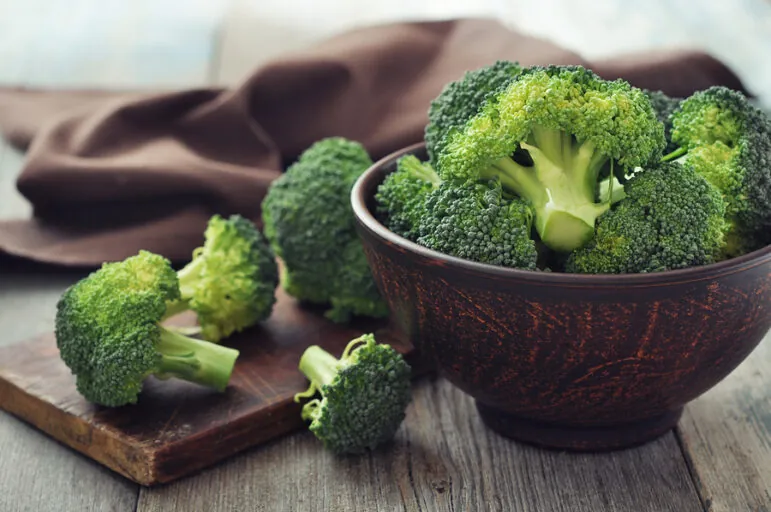
A single variety, originally grown in the Italian Province of Calabria, was eventually given the name Calabrese and became world famous. You can still find seeds for this strain among heirloom seed collectors and sellers. Broccoli’s common name, however, comes from the Latin word ‘brachium,” which means branch or arm.
- Broccoli has been grown in America’s gardens for about 200 years.
- The first broccoli grown commercially was harvested in New York.
- Growers planted the first California Central Valley crops in the 1920s.
- By 1925, the broccoli market had taken off, and health professionals touted it for its anti-cancer nutrients. These nutrients are shared by other cruciferous vegetables like bok choy, Brussels sprouts, cabbage, cauliflower, and kale.
- Consumption of broccoli has jumped almost 950 percent during the last 25 years, and for excellent reasons. Broccoli contains Vitamin A, Vitamin C, potassium, folascin, iron, and fiber.
- Broccoli is also loaded with calcium and a number of seriously nourishing phytochemicals, including beta-carotene, indoles, and isothiocyanates. For those who missed the lecture, phytochemicals prevent cancer-causing substances from forming and getting to target cells.
- Heads of broccoli actually signal shoppers how ripe and healthy they are. Dark green overall is the best color, but florets can span the color range from dark green to purplish, even bluish green. These florets contain more beta-carotene and vitamin C than paler or yellow-fading- to-white ones.
- Broccoli also contains soluble and non-soluble fibers, both needed by a healthy body. It also contains the flavonoid kaempferol, which in addition to fighting cancer helps prevent heart disease and slow the onset of Type 2 diabetes.
- When shopping, ignore rubbery stalks, open, flowering, discolored florets, and tough, wood stems. Left on the counter or in the crisper for a day or more, it may begin to exhibit symptoms like yellow flowering, wilting, and increasing tough stems.
- In the debate of fresh vs. frozen, there is no real winner. Flash-freeze packaging producers cut off the woody stems, leaving more of the nutritious part of broccoli for your family’s eating pleasure. On the flip side, the frozen product contains twice as much sodium as fresh-picked.
The best way to cook broccoli is inside a steamer. These aluminum ‘bowls’ made of many slats of welded metal with a handle look like imaginative umbrellas for elves. When used properly, they deliver broccoli so perfectly steamed that each part is succulent and tender.
Americans are runners-up in the spinach-eating game, but when it comes to broccoli, China is number 1. After all, you couldn’t call their most famous dish beef and spinach, could you?
In Arizona, where broccoli is a major crop, revenues of more than 40 million plump up the state’s economy while providing yet another green superfood for you and your family! FillYourPlate, an online directory of Arizona retail farmers and ranchers, says broccoli is ready to harvest in Arizona all through the winter and spring, from October through March.
Go to FillYourPlate. Choose a source. Get it fresh, make a tangy, low-cal dip, add carrots for color, and vine-on tomatoes for their superb red and reliable sweetness. FillYourPlate also has some superb recipes.
Finally, invite friends and watch a pioneer movie showing how immigrants arrived in America with their goats, sheep, cows, chickens, ducks, and paper packets of garden seed cherished more than gold.
Related articles
- 30 Things to Do with Broccoli (fillyourplate.org)
- Training Your Brain to Crave What’s Good for You (fillyourplate.org)
- 9 Foods to Help You Lose Weight (fillyourplate.org)
9 Foods to Help You Lose Weight
Beating Back the Bulges
Are you one of the more than nine million Americans (and 1.8 million Arizonians) who have vowed to lose weight in 2015?
You should know that you are in good company. From a list of the top 10 New Year’s resolutions for 2014, weight loss was number one. It’s also encouraging to know that losing pounds and inches is now easier than ever, thanks to fresh, healthy, affordable, Arizona-grown produce.
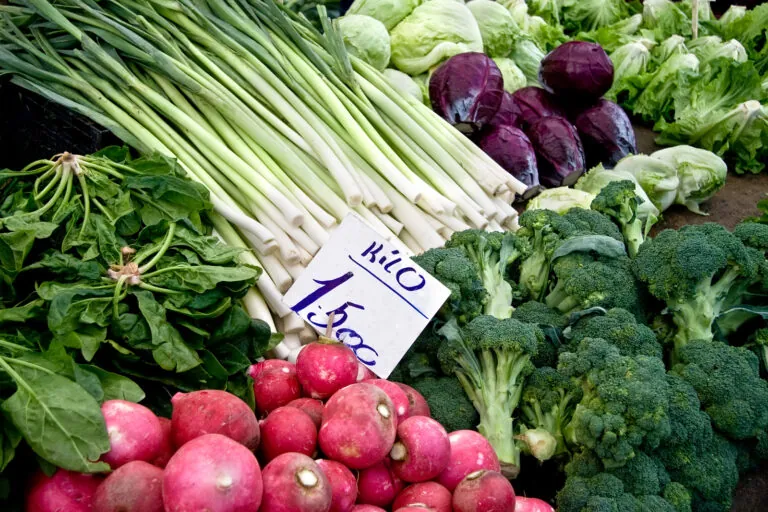
More important, you no longer have to starve yourself. Sensible dieting combined with moderate exercise will peel the pounds better than any “crash” diet. If you go one step further, changing your eating habits and your lifestyle, those pounds will never return.
The secret is simple: a constant supply of fresh or lightly steamed vegetables to keep you from feeling so desperately hungry you eat an entire quart of ice cream! We have chosen nine of the vegetables in season between now and March, in order of their ripening, that are the best fat-fighters from the farm.
In January, choose:
- Broccoli, a powerhouse of nutrients. At about 31 calories per serving, it is low in sodium and high in fiber and protein. But skip the dip if you eat it raw.
- Sweet potatoes, surprisingly delicious and nutritious, a half cup is only 100 calories and helps delay aging, according to some experts.
- Beets. The source of most granulated sugar, beets are amazingly low in calories. Just 59 per cup, with only 13 grams of carbohydrates (or carbs) per serving and loaded with Vitamin C. Indulge.
In February, select:
- Brussels sprouts, the “little cabbages” of childhood. At only 38 calories per cup and an astonishing amount of potassium, you can gorge and still feel virtuous – though we recommend you don’t. Stretching your stomach just makes dieting harder.
- Cabbage, at 6 calories per leaf, you can make cabbage rolls with meat, tomatoes, and spices (hold the rice) and have at least four without feeling you have let yourself down.
- Rutabagas or turnips. A medium-sized rutabaga is 145 calories and 33 carbs, but contains record amounts of Vitamin C, Vitamin B-6 and magnesium. When your diet has you feeling dragged out, eat a rutabaga. It will feel like you have grown wings! Turnips are even lower in calories and carbs (34 per, and only eight carbs), but deliver 42 percent of the adult daily requirement of Vitamin C.
In March, buy:
- Parsnips. I call them the miracle vegetable. When my kids were young, they actually liked parsnips. The secret to sweetness is to leave them in the ground after frost. At 100 calories per cup, and 24 grams carbs, they also deliver record amounts of Vitamin C. But it’s the potassium that surprises. Almost 500 mg! Who needs mineral supplements?
- Spinach, Popeye’s favorite food, is also a dieter’s favorite. Containing a mere 7 calories per cup, and one gram of carbs, it provides more than half the daily requirement of Vitamin A in a gorgeous green that doesn’t fade even when steamed. Try lemon spinach (or any one of a hundred other recipes from Fill Your Plate, which also offers lists of local growers and farmers’ markets). Yum!
- Strawberries. They’re not a vegetable, but 10 medium-sized berries will net you 30 calories and a measly 0.5 carbs. The way I figure it, by March, when the first ones ripen, you will want to treat yourself for being such a faithful dieter. You might even add a dollop of cream and a sprinkle of real or artificial sweetener.
Happy dieting!
Related articles
- Top 10 “All You Can Eat Foods” and Still Lose Weight (fillyourplate.org)
- 15 Fun Facts about Food (fillyourplate.org)
- How to Make Realistic Weight Loss Resolutions (fillyourplate.org)
Looking Forward: Green is the Color of Food Trends in Arizona for 2015

Following a trend that has been developing all across the nation for the past few years, it looks like Arizona’s 2015 food trends will involve a fair amount of green. In Arizona, where agricultural innovations have led to a $17.1-billion food, fiber and ornamental plant industry, that green is produce straight from the farm and full of all the vitamins, minerals and rare earth elements Nature intended.
Whether it’s celery, bok choy, or leeks, vegetables grown in good earth, watered with clean water, picked at the height of ripeness and shipped no more than a dozen miles to the nearest Arizona farmer’s market – or delivered direct to residents via more than a dozen Community Supported Agriculture (CSA) services – this “farm fresh food” offers families and individuals the opportunity to eat as if it really mattered. Because it does.
The other green is money, of course, since eating fresh, local, and in season can be more expensive than fast food or packaged meals and dinners, depending on where you shop. But isn’t your family worth the added cost? Especially when that amount can be easily carved out of the weekly budget.
How?
- If you currently spend $200 a week for a family of four, selectively buying fresh, local produce will cost you an additional $24. If you skip your daily Starbucks boost and bring coffee from home in a thermos (fancy fixings on the side), you can save that and more.
- Carpool. The average commute now costs – hang on to your hat – $43,000! Even one other person halves that. Divide by four? Well, you get the picture…
- Pack a lunch instead of buying one and you can save a whopping $40 a week. Plus, you know where your food is coming from. With what you save, you can branch out into some locally grown tangerines, grapefruit, or those intensely sweet little oranges called Clementines. Find these and other treats on the Arizona Farm Bureau’s Fill Your Plate website, which will also direct you to the more than 200 farmer’s markets and CSAs, one of which is sure to be close to where you live. Many are also open all year long.
- Shrink your meal-planning horizons. In this sedentary era of computers, humans don’t need the kind of caloric intake common 100 years ago. Instead, think in terms of toasted ham and cheese sandwiches, a salad, and fresh green beans vinaigrette for dinner. Take leftovers as lunch.
- Foodies know that plan-ahead meals not only taste better but also save beaucoup bucks! Take 90 minutes to make and freeze a week’s worth of entrees – and here’s where farmer’s-market shopping comes in handy, because how else are you going to use up that basket of beans you bought? Fortunately for you, Fill Your Plate also has recipes.
You probably won’t have the time to visit an Arizona farmer’s market every weekend, but you can rest assured of your family’s health knowing that many Arizona grocers buy the same locally grown fruit and produce that you do. So go shopping and enjoy the green bounty of Arizona in 2015!
8 Tips for Getting Enough Healthy Protein
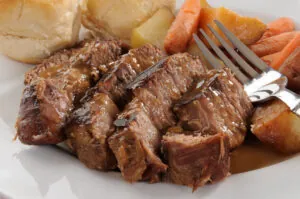
Protein is essential to good health because it is involved in every critical function within your body. On average, American adults should be getting 10-35% of their calories each day from protein. For men that means about 56 grams and for women it means about 46 grams. You can get ample protein simply from eating a diet based on meat. Of course, you want a balance of meat and plant proteins. These eight tips will help you get enough protein.
1. Focus on Lean Meats
Meat definitely has a place in a diet filled with healthy protein and you have easy access to lean pork, beef, and chicken. The reason you need seafood and red meat in your diet is because it’s the best source of zinc, an essential mineral required by the body for maintaining a sense of smell, keeping a healthy immune system, building proteins, triggering enzymes, and creating DNA. While some plant proteins can provide this important mineral too, they can’t at the level and quality of seafood and red meats. Beef and other red meats are also a good source of iron, choline (that supports our nervous system development) and selenium (helps protect cells from damage).
2. Diversify
When most of us think of protein, meat is all that comes to mind but there are many other sources of protein that are not meat based. Varying the sources of your protein can help you manage calorie and fat intake while also keeping meal time interesting and inviting.
3. Re-acquaint Yourself with the Incredible Edible Egg
Eggs, like the ones produced by Arizona farms, are a great source of protein. Adding an egg to your morning breakfast plate or eating a hard boiled one for a snack are both easy ways to get this healthy protein into your day.
4. Go Nuts!
Nuts, seeds, legumes, and beans are all excellent sources of healthy proteins. Nuts and seeds make great snacks and beans, lentils, and other legumes are perfect ways to add protein to a soup, stew, or salad.
5. Dip Into Some Dairy
Dairy products like milk, cheese, and yogurt are all also good sources of healthy protein. Including low-fat dairy products at various points throughout the day will help you get your protein and boost your calcium intake.
6. Eat it on the Side
Many times the protein in our meal features prominently on the plate and is considered the main course, but there are lots of delicious side dishes that also provide healthy protein. Eating things like hummus, bean salad, and lentils which are all excellent sources of protein will make it easy to get the right amount of protein without the entire meal centering on protein.
7. Have a Salad
Many of the dark leafy green vegetables that are so good for us also provide a healthy source of protein. Vegetables like spinach, kale, Brussels sprouts, broccoli, and even artichokes serve us a solid helping of protein along with all the other vitamins and nutrients they provide.
8. Go for the Grain
There are some ancient grains like quinoa and amaranth are packed with protein and full of fiber. Using them instead of carb heavy potatoes or rice can help you get more healthy protein without the extra calories.
Related articles
- 15 Fun Facts About Food (fillyourplate.org)
- 7 Quick and Easy Affordable Dinner Ideas (fillyourplate.org)
- 30 Things to Do With Kale (fillyourplate.org)
Let’s Celebrate Arizona Grown Leafy Greens
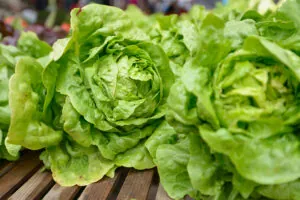
November is the month of gratitude and if there is one thing we have to be grateful for here in Arizona it is the abundance of locally grown leafy greens produced during the fall and winter months. While you might not think ‘leafy greens’ when you think ‘desert climate’, the winter weather in Arizona is actually perfect for growing these healthy veggies.
Our climate is so leafy green friendly in fact that Yuma, Arizona is the winter lettuce capital of the world and more than 1,000 truckloads of lettuce leave the Yuma Valley every day this time of year. The leafy greens produced in Arizona from November to March will account for about 85% of all the leafy greens consumed in both the U.S. and Canada during that timeframe.
In addition to contributing to the food supply, these leafy greens also play an important role in Arizona agriculture by contributing $1 billion a year to the economy and employing more than 20,000 people. To help you celebrate these locally grown veggies and get more of them in your daily diet, here is some basic information about the top Arizona grown leafy greens according to Arizona Leafy Greens and some ways you can use them to fill your family’s plate.
Arugula
Popular in Mediterranean cuisine, arugula has a distinct peppery flavor and an excellent nutritional profile. It provides vitamins A, C, and K, folates, and beneficial phytochemicals.
Cabbage
Most people are familiar with cabbage, which is a good source of fiber.
- Albondigas Meatball Soup
- Apple Bacon Slaw
- Balsamic Green Beans with Pine Nuts
- Classic Minestrone Soup
- Cole Slaw
- Mexican Cole Slaw
Chard
This leafy green stands out from the others because of its brightly colored stalks and veins which come in a rainbow of colors. With a taste similar to beets, chard is a good source of fiber and provides both vitamins A and C.
Kale
This leafy green powerhouse is packed with nutrition and provides vitamins A, C, and K, folate, potassium, and even calcium. It has a more bitter taste than most lettuce varieties and comes in a range of colors.
- Bacon, White Bean, and Kale Skillet
- Parmesan Kale Chips
- Turkey Sausage with Spicy Beans
- Cashew Pesto Kale Chips
Lettuce including Butter, Iceberg, Green Leaf, Red Leaf, Baby Leaf, and Romaine
Lettuce provides a good source of vitamins A, C, and K, and potassium, the darker the leaves, the higher the concentration of nutrients. It is also a good source of dietary fiber.
- Asian Lettuce Wraps
- Chicken Lettuce Wraps
- Chopped Medjool Date Salad
- Crunchy Apple Salad
- Goat Cheese Lettuce Wraps
- Green Salad
- Grilled Romaine with Creamy Balsamic Vinaigrette
- Join the Party Salad
- TABLE Cosmos
- Tostados
Spinach
Spinach provides folate, vitamins A and C, and is actually better for you when it is cooked, unlike most of the other leafy greens.
- Fennel Spinach Pasta
- Lemon Spinach
- Greek Chicken
- Chicken Picatta
- Eggs Sardou
- Pasta with Goat Cheese
- The Farmer’s Favorite Salad
Related articles
- Let’s Talk Lettuce (fillyourplate.org)
- Little Known Facts About Lettuce (fillyourplate.org)
- Top 5 Healthy Back to School Snacks (fillyourplate.org)
30 Things to Do With Kale
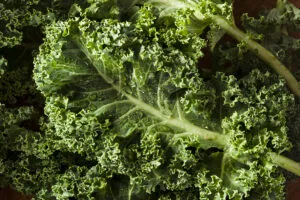
If there is one thing that is “hot” in the world of leafy greens right now, it is kale. This dark leafy green vegetable has been rapidly increasing in popularity in the United States over the past two years and experts don’t expect that to change any time soon.
Kale is so packed with nutritional value that it scores perfect 1,000 on the Aggregate Nutrient Density Index (ANDI), a food-rating system that measures nutrients per calorie. It’s easy to see why some people call it a superfood when you look at what a single small serving of kale provides. When boiled, 3.5 ounces of kale provides the following:
- 28 Calories
- 6 g of Sugar
- 2 g of Dietary Fiber
- 9 g of Protein
- .4 g of Fat
- 13,621 IU of Vitamin A
- 778% of the RDA for Vitamin K
- 49% of the RDA for Vitamin C
- 20% of the RDA for Manganese
- 11% of the RDA for Vitamin B6
- 7% of the RDA for Calcium
- 7% of the RDA for Iron
- 6% of the RDA for Riboflavin (Vitamin B2)
- 6% of the RDA for Vitamin E
- 5% of the RDA for Thiamine (Vitamin B1)
And that’s just one small serving of this nutrient dense and delicious vegetable!
Kale is a type of cabbage that can have dark green or purple leaves. Kale is sweeter than some of the other dark leafy greens and is a great addition to salads and soups. It has thicker, crunchier leaves than most other greens, which is why one of the most popular uses is to make it into chips.
More and more kale is being grown here in Arizona during the winter months. To help you incorporate this healthy veggie in your daily diet, here are some other ideas for using kale.
- Bacon, White Bean, and Kale Skillet
- Kale Salad
- Sautéed Kale
- Cashew Pesto Kale Chips
- Pan-seared Salmon with Kale and Apple Salad
- Kale and Quinoa with Creole Seasoning
- Parmesan Kale Chips
- Grilled Chicken with Roasted Kale
- Turkey Sausage with Spicy Beans
- Roasted Beet and Kale Salad
- Kale Citrus Salad
- Whole Wheat Pasta with Kale and Roast Chicken
- Roasted Yam and Kale Salad
- Kale and Apple Salad
- Pork Tenderloin with Steamed Kale
- Sausage, Kale, and Lentil Soup
- Orzo with Kale
- Lemony Lentils with Kale
- BBQ Kale Chips
- Garlic Kale
- Creamy Kale Salad
- Butternut Squash and Kale Stir Fry
- Turkey, Garbanzo Beans, and Kale Soup
- Braised Kale, Sausage, and Creamy Polenta
- Chile Rubbed Chicken Breast with Kale, Quinoa, and Brussels Sprouts Salad
- Kale and Feta Salad
- Kale, Swiss Chard, Chicken, and Feta Cheese Salad
- Roasted Squash and Kale Salad
- Spicy Kale and Corn Stuffed Chicken Breast
- Acorn Squash and Kale over Penne
Related articles
- Getting Creative With Kale (fillyourplate.org)
- 50 Fun Ways to Use Apples (fillyourplate.org)
- 40 Reasons to Be Mad for Mangoes (fillyourplate.org)
Ingredients that Matter When We Have a Snack Attack

People all around the world love to snack which is apparent when looking at the results of Nielsen’s Global Survey of Snacking. This $374 billion industry just keeps growing and it isn’t the biggest snackers on the planet, Americans and Europeans, driving most of that growth. While the total year over year increase in money spent on snacks increased by 2% globally, it was the up and coming snackers in regions like Latin America, Asia-Pacific, and the Middle-East (9%, 5%, and 4% respectively) that helped fuel the increase.
When it comes to what kind of snacks we like, there are two main drivers, taste, which is obvious, and health considerations, which isn’t. In fact, the survey showed that these two are almost equal in importance and that when it comes to choosing the snack we want; we aren’t really interested in compromising.
Although many people might think of ‘sweets’ when they hear ‘snacks’, the savory snack category is actually growing faster than any other category. These are the snacks that we most often use to replace a regular meal which is one reason this category is growing so fast. Things like crackers, rice cakes, meat jerky, yogurt, and cheese are all experiencing the fastest-growth in almost every region.
This underscores one of the key findings of the survey – when it comes to snacking, consumers are focused on how those snacks can help or hurt their health. Traditional sweet snacks like cookies and confections still reign supreme when it comes to snack sales but as the focus shifts more and more to snacking healthy, it is the snacks that are seen as ‘healthy’ that are driving sales and growth.
When it comes to how we choose our healthy snacks or how we decide if a snack is healthy or not, ingredients matter. What our snacks contain or what they do not contain is one of the most important factors we consider when choosing a healthy snack. When asked to rank 20 different attributes that are important when choosing a healthy snack almost half of those who participated in the survey put snacks with all natural ingredients at the top of the list. We also want snacks that are high in fiber and protein and those that are made with whole grains.
What is not in our snacks is almost as important as what is when it comes to what we choose. The demand for specialty snacks like those that do not contain caffeine or that are gluten-free are also seeing an increase in demand. Demand for snacks that are low in sugar, salt, fat, carbohydrates, and calories is also increasing as the focus shifts from sugary sweet snacks to healthy snacks. Other key factors included the lack of artificial colors, genetically modified organisms, and artificial flavors.
The survey collected information from more than 30,000 consumers from more than 60 countries in their online campaign. Participants were asked to provide information on which attributes affected their snack selections in categories like health, taste, and texture. For more information about the survey, visit Nielsen’s website.
Fill Your Plate has a great mix of recipes including desserts that might satisfy that snack attack urge in you.
Related articles
- Top 5 Healthy Snacks for Back to School (fillyourplate.org)
- Are Your Kids Eating Right? (fillyourplate.org)
- B is for Breakfast (fillyourplate.org)
50 Fantastic Ways to Use Figs
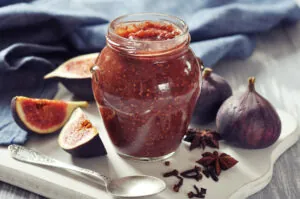
There is nothing quite like the sweet taste and chewy texture of fresh figs. As the fruit of the Ficus tree, figs come in a variety of colors and textures and offer a tasty treat that is as good for you as it is good to eat. One medium size fig has about 40 calories and is high in dietary fiber. Figs are also high in potassium which can be beneficial in helping lower and control blood pressure. For those looking to lose a little weight, the fiber in figs can help you feel full and satisfied longer, making it easier to avoid high calorie filler foods.
To help you celebrate this fabulous fruit this month, here are 50 fantastic ways to use figs to fill your family’s plates.
- Fig and Arugula Salad
- Pork Loin with Fig and Port Sauce
- Seared Figs and White Peaches with Balsamic Reduction
- Fig Spice Cake
- Fig and Almond Tarts
- Fig and Blue Cheese Stuffed Pork Tenderloin
- Fig and Onion Spread
- Prosciutto Wrapped Figs
- Fig Goat Cheese Bruschetta
- Fig and Brie Crostini
- Fig Prosciutto Pizza with Arugula
- Fresh Fettuccine with Figs, Prosciutto, and Goat Cheese
- Fig Prosciutto Gorgonzola Salad
- Fig Smoothie
- Honey Glazed Grilled Fig salad with Feta, Pistachio, and Mizuna
- Fig and Walnut Sticky Buns
- Fig and Olive Tapenade
- Chicken Panini with Fig Jam
- Fig and Lemon Chicken
- Fresh Pear and Fig Mixed Green Salad
- Fig Pecan Macaroons
- Fresh Fig Cookies
- Fig and Walnut Cookies
- Fig, Date, and Walnut Quick Bread
- Fig Bars
- Flatbread with Fresh Figs, Monterey Jack Blue Cheese, and Red Wine Reduced Vinaigrette
- Crostini with Gorgonzola, Caramelized Onions, and Fig Jam
- Fig and Banana Loaf
- Roasted Fresh Figs with Gorgonzola
- Granola Honey Yogurt with Figs
- Fig and Ricotta Crostini
- Fig Bran Muffins
- Strawberry Fig Preserves
- Spinach Sautéed with Garlic, Figs, and Honey
- Figs Stuffed with Almonds and Chips
- Creamy Leon Pepper Orzo with Chicken and Fig Salad
- Citrus Grilled Pork Filet with Mint Fig Sauce
- Four Cheese Pizza with Fig and Proscuitto
- Fresh Fig Compote Over Cream Cheese
- Fresh Figs with Rosemary Goat Cheese
- Chicken with Figs in a Port Wine Sauce
- Pan-seared Foie Gras with Figs and Port Wine Sauce
- Stuffed Bison Burgers with Caramelized Figs and Shallots
- Prosciutto Fig and Goat Cheese Quesadillas
- Bourbon Fig Compote
- Pecorino Romano with Apples and Fig Jam
- Sweet Figgy Pudding
- Montalcino Chicken with Figs and Buttered Gnocchi with Pancetta and Nutmeg
- Turkey Sliders with California Pepper Fig Salsa
- Pita Pockets with Fresh Figs and Roasted Chicken
Related articles
- How to Use Food to Manage Your Cholesterol (fillyourplate.org)
- Mad about Mangoes (fillyourplate.org)
- Get to Know Your Leafy Greens (fillyourplate.org)

